About Brigandine arms' protection
This section contains different types of brigandine arm protection. Here you can see various models of medieval protection, which was widespread in Europe, Asia and Вyzanthium.
Every item is handcrafted according to customer’s parameters. Brigandine and splinted armour is based on the original samples, which you can see in the old manuscripts, in museums or on the gravestones.
To order bracers of full brigandine arm’s protection, you need to do few simple steps:
- Open the wished item;
- Choose type and thickness of metal plates;
- Define colour of leather
- Select metal for rivets and buckles (steel or brass)
If you have any problems with order, please contact our manager. We’ll help you to define your size, required model and its complement.
Once all options have chosen, you need to add item to the cart and make a payment. After that, manager will contact you with measurement request and specification of order’s details.
All samples of brigandine and splinted bracers, bicep protection and full arms are perfect for participation in the tournaments of medieval fencing, historical festivals, bohurts and reenactment events. Depending on the complement, such defense is compliant to the standards and rules of such social movements, as SCA (The Society for Creative Anachronism), HEMA (Historical European Martial Arts), HMB (Historical medieval battles).
If you did not find the wished armour in this section, we can make it individually for you. Just send picture with detailed description to [email protected]. Then we will quote you and discuss details of order.
History of the Middle Ages provides us with a lot of evidences of usage of brigandine arm’s defense. Steel plates were riveted with overlap on the leather or cloth base. Such method gave high level of protection of crushing blows, stabs and slashes. At the same time, such armour did not hinder movements of knight and weighed less than chainmail. Besides, it was rather easy to make such armour (skills of top-level armorer were not required). Every competent forger could create brigandine elements. In addition, comparing to plate armour, brigandine protection was cheaper.

These features determined almost all-round usage of brigandine armour in the XIII-XIV centuries. But as historical sources shows, knights were used to wear brigandine bracers and protection of upper arm even in the XII century. These elements of medieval protection can be seen on the frescoes of Karner tower (Hartberg, Austria).
Brigandine armour hadn’t get out of fashion even with development of plate defense. Combined splinted protection was the most widespread variant. Typical feature was riveted plates on the outside and inner side of base. Such design was raising protection properties of armour and didn’t have any gaps for blades.
At the same time, combination of splinted and plate elements became very popular among knights. For example, brigandine or splinted bracers and protection of upper arm were complemented with plate elbow caps.

These details didn’t reduce mobility and covered joints. On the statue of Günther von Schwarzburg (Frankfurt-Am-Mein, Germany), you can see combination of brigandine bracers and bicep armour, and plate elbow caps. Such version of protective gear was typical for the XIV-XV centuries and usually was completed with plate spaulders and gauntlets. So, warrior’s arms were almost completely defendable.

-0-1-0-1-1-300x400.jpg?v=1746523880)


-0-1-0-1-1-300x400.jpg?v=1746523880)











